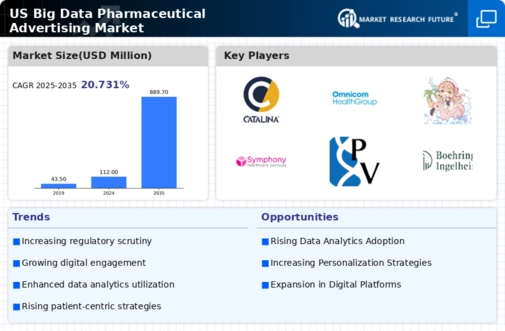Rising Demand for Data-Driven Insights
The increasing demand for data-driven insights in the pharmaceutical sector is a key driver for the big data-pharmaceutical-advertising market. Pharmaceutical companies are increasingly relying on data analytics to inform their marketing strategies, optimize their advertising spend, and enhance customer engagement. In 2025, it is estimated that the market for data analytics in pharmaceuticals will reach approximately $10 billion, reflecting a compound annual growth rate (CAGR) of around 15%. This trend indicates that companies are prioritizing data utilization to gain competitive advantages, thereby propelling the growth of the big data-pharmaceutical-advertising market.
Growing Focus on Patient-Centric Marketing
The shift towards patient-centric marketing strategies is emerging as a significant driver in the big data-pharmaceutical-advertising market. Pharmaceutical companies are increasingly recognizing the importance of tailoring their marketing efforts to meet the specific needs and preferences of patients. This approach not only enhances patient engagement but also improves the effectiveness of advertising campaigns. In 2025, it is anticipated that patient-centric marketing will account for over 30% of total pharmaceutical advertising expenditures, indicating a substantial shift in focus. This trend underscores the necessity for data analytics to inform and refine marketing strategies.
Increased Investment in Digital Advertising
The surge in digital advertising investments is a notable driver for the big data-pharmaceutical-advertising market. As traditional advertising channels become less effective, pharmaceutical companies are reallocating their budgets towards digital platforms. In 2025, digital advertising is projected to represent approximately 50% of total pharmaceutical advertising spending, reflecting a growing reliance on data analytics to optimize campaigns. This shift not only allows for more targeted advertising but also enables real-time performance tracking, thereby enhancing the overall effectiveness of marketing efforts in the industry.
Advancements in Data Collection Technologies
Technological advancements in data collection methods are significantly influencing the big data-pharmaceutical-advertising market. Innovations such as mobile health applications, wearable devices, and IoT technologies are enabling pharmaceutical companies to gather vast amounts of real-time data. This data can be analyzed to understand patient behaviors, preferences, and treatment outcomes. As of 2025, the integration of these technologies is expected to enhance the effectiveness of advertising campaigns, leading to a projected increase in market value by 20%. Consequently, the ability to collect and analyze data efficiently is becoming a crucial driver for the industry.
Regulatory Changes Favoring Data Utilization
Recent regulatory changes are shaping the landscape of the big data-pharmaceutical-advertising market. New guidelines are emerging that encourage the ethical use of data while ensuring patient privacy. These regulations are likely to facilitate greater data sharing among pharmaceutical companies, enabling them to leverage insights for more effective advertising strategies. By 2025, it is expected that compliance with these regulations will enhance the credibility of data-driven marketing efforts, potentially increasing market growth by 10%. This evolving regulatory environment is thus a critical driver for the industry.


























Leave a Comment